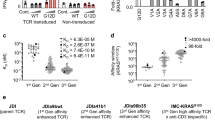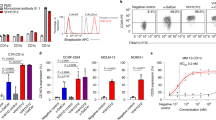Abstract
Our previous studies have described a rare type of antibody that spontaneously binds to itself, or homodimerizes. This self-binding, or autophilic antibody provides stronger protection against bacterial infection than a non-self-binding antibody with identical specificity and affinity, due to an increase of polymeric avidity. Furthermore, we have shown that a peptide derived from the self-binding domain of the autophilic T15 antibody can be crosslinked to the Fc carbohydrate of monoclonal antibodies specific for the B-cell receptor of B-cell tumors. These peptide-crosslinked antibodies can exert self-binding properties, leading to an increase in binding efficiency to the target cells as well as an increase in potential to induce apoptosis. Herein, we report a novel finding that crosslinking of the autophilic T15 peptide rescues a loss-of-function chimerized (ch) anti-GM2 antibody. The parental antibody demonstrates in vivo anti-tumor activity against melanoma xenografts. The T15 peptide-conjugated antibody shows the ability to bind to itself, as well as an increased binding to its antigen, ganglioside GM2. Moreover, the peptide-conjugated antibody also demonstrates an increased ability to bind to two GM2-positive tumor cell lines and notably important, restores its ability to induce apoptosis in two types of tumor cells. These results provide strong support for the clinical potential of the autophilic technology.






Similar content being viewed by others
References
Walsh G (2004) Modern antibody-based therapeutics. BioPharm Int 1–5
Birkle S, Zeng G, Gao L, Yu RK, Aubry J (2003) Role of tumor-associated gangliosides in cancer progression (Review). Biochimie 85:455–463
Nakamura K, Tanaka Y, Shitara K, Hanai N (2001) Construction of humanized anti-ganglioside monoclonal antibodies with potent immune effector functions. Cancer Immunol Immunother 50:275–284
Retter MW, Johnson JC, Peckham DW, Bannink JE, Bangur CS, Dresser K, Cai F, Foy TM, Fanger NA, Fanger GR, Woda B, Rock KL (2005) Characterization of a proapoptotic antiganglioside GM2 monoclonal antibody and evaluation of its therapeutic effect on melanoma and small cell lung carcinoma xenografts. Cancer Res 65:6425–6434
Kang CY, Kohler H (1986) Immunoglobulin with complementary paratope and idiotope. J Exp Med 163:787–792
Kang CY, Brunck TK, Kieber-Emmons T, Blalock JE, Kohler H (1988) Inhibition of self-binding antibodies (autobodies) by a VH-derived peptide. Science 240:1034–1036
Zhao Y, Lou D, Burke J, Kohler H (2002) Enhanced anti B-Cell tumor effects with anti-CD20 superantibody. J Immunother 25:57–62
Zhao Y, Kohler H (2002) Enhancing tumor targeting and apoptosis using non-covalent antibody homodimers. J Immunother 25:396–404
Suzuki Y, Hirabayashi Y, Matsumoto N, Kato H, Hidari K, Tsuchiya K, Matsumoto M, Hoshino H, Tozawa H, Miwa M (1987) Aberrant expression of ganglioside and asialoglycosphingolipid antigens in adult T-cell leukemia cells. Jpn J Cancer Res 78:1112–1120
Fernandes DM, Baird AM, Berg LJ, Rock KL (1999) A monoclonal antibody reactive with a 40-kDa molecule on fetal thymocytes and tumor cells blocks proliferation and stimulates aggregation and apoptosis. J Immunol 163:1306–1314
Ward RE, McNamara-Ward M, Webb CF, Altman D, Lim PK, Tucker PW, Kohler H (1988) Regulation of an idiotype+ B cell lymphoma: effects of antigen and anti-idiotypic antibodies on proliferation and Ig secretion. J Immunol 141:340–345
Hasbold J, Klaus GGB (1990) Anti-immunoglobulin antibodies induce apoptosis in immature B cell lymphomas. Eur J Immunol 20:1685–1690
Wallen-Ohman M, Lonnbro P, Schon A, Borrebaeck CAK (1993) Antibody-induced apoptosis in a human leukemia cell line is energy dependent: thermochemical analysis of cellular metabolism. Cancer Lett 75:103–109
Ghetie MA, Picker LJ, Richardson JA, Tucker K, Uhr JW, Vitetta ES (1994) Anti-CD19 inhibits the growth of human B-cell tumor lines in vitro and of Daudi cells in SCID mice by inducing cell cycle arrest. Blood 83:1329–1336
Ghetie MA, Podar EM, Ilgen A, Gordon BE, Uhr JW, Vitetta ES (1997) Homodimerization of tumor-reactive monoclonal antibodies markedly increases their ability to induce growth arrest or apoptosis of tumor cells. Proc Natl Acad Sci USA 94:7509–7514
Chester K, Pedley B, Tolner B, Violet J, Mayer A, Sharma S, Boxer G, Green A, Nagl S, Begent R (2004) Engineering antibodies for clinical applications in cancer (Review). Tumour Biol 25:91–98
Gorman SD, Clark MR (1990) Humanisation of monoclonal antibodies for therapy (Review). Semin Immunol 2:457–466
Grey HM, Hirst JW, Cohn M (1971) A new mouse immunoglobulin: IgG3. J Exp Med 133:289–304
Ehrlich PH, Moyle WR, Moustafa ZA, Canfield RE (1982) Mixing two monoclonal antibodies yields enhanced affinity for antigen. J Immunol 128:2709–2713
Greenspan NS, Monafo WJ, Davie JM (1987) Interaction of IgG3 anti-streptococcal group A carbohydrate (GAC) antibody with streptococcal group A vaccine: enhancing and inhibiting effects of anti-GAC, anti-isotypic, and anti-idiotypic antibodies. J Immunol 138:285–292
Greenspan NS, Dacek DA, Cooper LJ (1988) Fc region-dependence of IgG3 anti-streptococcal group A carbohydrate antibody functional affinity. I. The effect of temperature. J Immunol 141:4276–4282
Chapman PB, Yuasa H, Houghton AN (1990) Homophilic binding of mouse monoclonal antibodies against GD3 ganglioside. J Immunol 145:891–898
Yan X, Evans SV, Kaminki MJ, Gillies SD, Reisfeld RA, Houghton AN, Chapman PB (1996) Characterization of an Ig VH idiotope that results in specific homophilic binding and increased avidity for antigen. J Immunol 157:1582–1588
Kaveri SV, Halpern R, Kang CY, Kohler H (1990) Self-binding antibodies (autobodies) form specific complexes in solution. J Immunol 145:2533–2538
Halpern R, Kaveri SV, Kohler H (1991) Human anti-phosphorylcholine antibodies share idiotopes and are self-binding. J Clin Invest 88:476–482
Zhao Y, Russ M, Morgan C, Muller S, Kohler H (2005) Therapeutic applications of superantibodies. Drug Discov Today 10:1231–1236
Acknowledgment
InNexus Biotechnology Inc. Vancouver, BC was funding this study. We thank Leslie Miller for the technical assistance in the InNexus/ImmPheron lab, and Jennifer Strange and Greg Bauman at University of Kentucky for their technical support on FACS analysis.
Author information
Authors and Affiliations
Corresponding author
Rights and permissions
About this article
Cite this article
Zhao, Y., Russ, M., Retter, M. et al. Endowing self-binding feature restores the activities of a loss-of-function chimerized anti-GM2 antibody. Cancer Immunol Immunother 56, 147–154 (2007). https://doi.org/10.1007/s00262-006-0182-2
Received:
Accepted:
Published:
Issue Date:
DOI: https://doi.org/10.1007/s00262-006-0182-2




